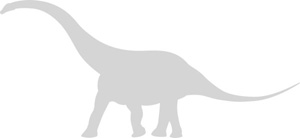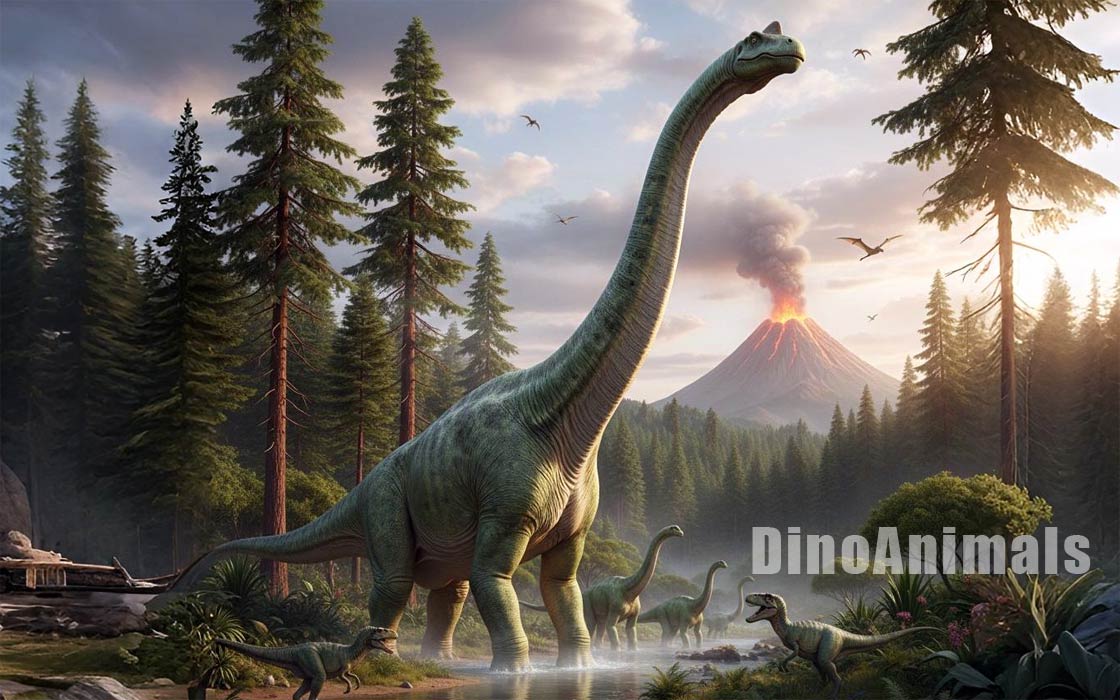Every month, 100,000 readers use the Dinosaur Database, but we receive no support from you. Developing and updating the database requires a lot of work. If you want it to remain open and be updated, please support us via the "Buy us a coffee" button available on every page or via the Support page.
Dinosaur: Maraapunisaurus fragillimus

| Length*: | 35 m | 114.8 ft |
| Weight*: | 70 t | 154,323 lb |
*The largest known specimen
Period
Epoch: Late Jurassic
Stage: Early Tithonian
Years: 149.2–145 Ma
Details
Status: nomen dubium
Author: Carpenter
Year: 2018
Distribution
Area: North America
Country: USA
Region: Colorado
Formation: Morrison
Description
Maraapunisaurus fragillimus
Maraapunisaurus fragillimus is a genus of sauropod dinosaur that, if confirmed, would rank among the largest terrestrial animals to have ever existed. Discovered in the Late Jurassic Morrison Formation, approximately 149-145 million years ago, Maraapunisaurus is known from very fragmentary remains and has sparked significant debate regarding its size and classification. Originally referred to as Amphicoelias fragillimus by Edward Drinker Cope in 1878, the genus was later reassigned to Maraapunisaurus based on more recent analyses. The name “Maraapunisaurus” derives from the Ute language, meaning “giant reptile,” while “fragillimus” refers to the fragile condition of the original fossil remains.
Physical Characteristics
Maraapunisaurus fragillimus is known from a single vertebra, which was described as being extraordinarily large and fragile. The specimen, however, was lost shortly after its initial discovery, leaving paleontologists to rely on Cope’s written descriptions and illustrations. Based on the available evidence, the vertebra was reported to be nearly 2.4 meters (7.8 feet) tall, suggesting that the dinosaur may have been significantly larger than other known sauropods, including Argentinosaurus and Patagotitan.
Extrapolations from the vertebra have led to size estimates ranging from 30 to 60 meters (98 to 197 feet) in length, and weights exceeding 120 metric tons (132 tons), though these estimates are highly speculative due to the lack of additional material. More likely estimates suggest 35 metres (~115 ft)) in length and 70 tonnes in weight. If accurate, Maraapunisaurus would have had an extremely long neck and tail, similar to other diplodocids, allowing it to reach high vegetation and cover vast areas while foraging.
The vertebra was highly pneumatic, meaning it contained extensive air sacs that lightened the skeleton while maintaining its strength, a common trait among sauropods. This feature would have been essential for supporting such an enormous body. The limbs were likely columnar, as in other large sauropods, and the tail would have been long and whip-like, possibly used for communication or defense.
Diet and Feeding Habits
As a herbivorous dinosaur, Maraapunisaurus fragillimus would have primarily fed on plant material. Its long neck would have allowed it to browse high in the canopy, feeding on conifers, cycads, and other Jurassic vegetation. The sheer size of the animal suggests it needed to consume vast quantities of plant matter daily to sustain its massive body.
Like other sauropods, Maraapunisaurus likely had peg-like teeth, suited for stripping leaves off branches rather than chewing. Food would have been swallowed whole and processed in its large, multi-chambered stomach, where it would have been broken down through fermentation. The presence of gastroliths (stomach stones) in other sauropods suggests that Maraapunisaurus may have used similar methods to aid in digestion.
Habitat and Distribution
Maraapunisaurus fragillimus lived in what is now North America, during the Late Jurassic period. The Morrison Formation, where the fossil was found, was a rich ecosystem of floodplains, river systems, and coniferous forests. This environment supported a wide variety of plant and animal life, including other giant sauropods like Diplodocus, Brachiosaurus, and Apatosaurus. The region’s climate was seasonal, with wet and dry periods that would have affected the availability of vegetation and water sources.
The Morrison Formation is well-known for its diverse dinosaur fauna, and Maraapunisaurus would have been one of the largest inhabitants of this ecosystem. It likely roamed vast distances in search of food and water, moving through forested areas and open plains in herds.
Behavior and Social Structure
Given its enormous size, Maraapunisaurus fragillimus was likely invulnerable to most predators, even large theropods like Allosaurus and Torvosaurus, once it reached adulthood. Like other large sauropods, it may have lived in herds, providing additional protection for juveniles and enhancing foraging efficiency. Herding behavior is commonly inferred for sauropods based on trackways and fossil evidence, suggesting that they moved together in search of food and water.
The long tail of Maraapunisaurus may have been used for communication within the herd, possibly producing sounds or visual signals. The animal’s slow growth rate and long lifespan—typical of large sauropods—meant that it took many years to reach full size, but once mature, it would have had few natural predators.
Discovery and Research
Maraapunisaurus fragillimus was first described by Edward Drinker Cope in 1878 based on a single dorsal vertebra discovered near Garden Park, Colorado. The fossil was noted for its extreme size and fragility, and Cope’s illustrations and measurements were used to estimate the animal’s overall size. Unfortunately, the original fossil was lost, likely disintegrating due to its fragile nature, leaving only Cope’s notes and sketches as evidence.
For decades, the identity and size of Maraapunisaurus were the subject of debate, with some paleontologists suggesting that Cope’s measurements were exaggerated or inaccurate. However, more recent studies have reassigned Amphicoelias fragillimus to a new genus, Maraapunisaurus, based on a re-examination of the available evidence and comparisons with other diplodocids. Despite the loss of the original fossil, Maraapunisaurus remains one of the most intriguing and potentially largest dinosaurs ever described.
Ongoing research continues to explore the possibility of finding more complete fossils of Maraapunisaurus or related species that could provide additional information about its anatomy, size, and evolutionary relationships. The lack of additional fossil material limits definitive conclusions about the dinosaur, but it remains an important figure in discussions of sauropod gigantism.
Significance and Interesting Facts
Maraapunisaurus fragillimus is significant for being one of the largest dinosaurs ever described, even though its classification and size estimates remain controversial. If the estimates are accurate, Maraapunisaurus would surpass other known giants like Argentinosaurus and Patagotitan in both length and mass.
One interesting fact about Maraapunisaurus is that its name reflects the fragility of the fossil material. The vertebra was so delicate that it likely disintegrated soon after discovery, leaving paleontologists to rely on written descriptions and sketches. This has made it one of the most elusive and debated dinosaurs in the fossil record, with its full appearance and size remaining speculative.
Locations
Sources
Material: Incomplete dorsal (lost) and distal end of a femur (lost).
References: Carpenter, K. (2018). "Maraapunisaurus fragillimus, n.g. (formerly Amphicoelias fragillimus), a basal rebbachisaurid from the Morrison Formation (Upper Jurassic) of Colorado".




